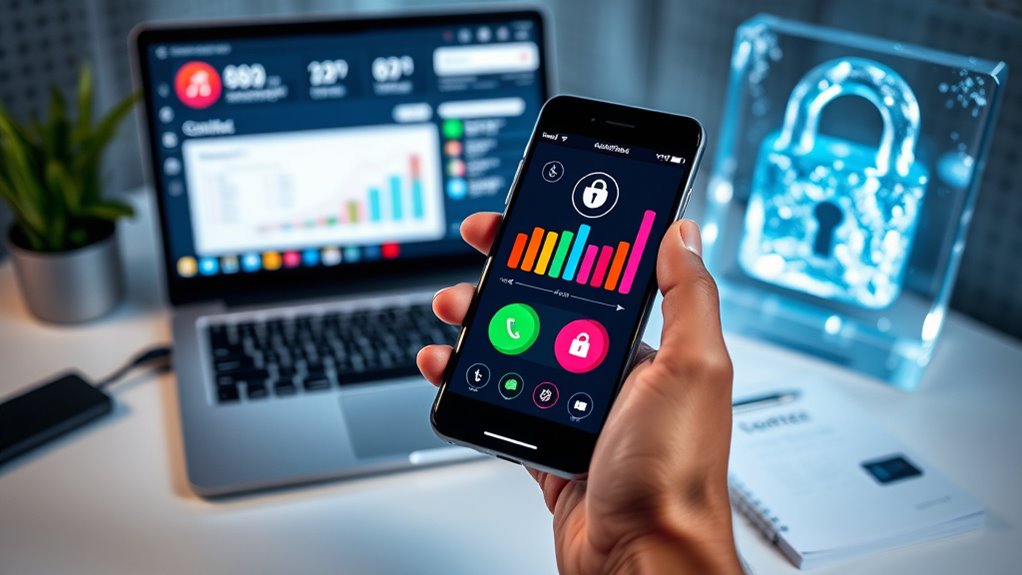If you want real-time alerts about suspicious activity on your credit, credit monitoring is a good choice because it provides ongoing updates and notifications. However, if you’re looking to block unauthorized access completely, placing a freeze is more effective, as it restricts access until you lift it. Each option offers benefits—monitoring shows risks early, while freezes prevent new accounts. To find out which suits your needs best, explore the detailed differences ahead.
Key Takeaways
- Credit monitoring provides real-time alerts for suspicious activity but does not prevent unauthorized access to your credit report.
- Security freezes block access to your credit reports entirely, preventing new accounts but require management of each bureau separately.
- Monitoring is more convenient with ongoing oversight and quick alerts, while freezes offer stronger, cost-free protection against new credit openings.
- Freezes are free to place and lift, whereas monitoring services can cost up to $20/month for enhanced features.
- Combining both methods offers layered security—freezes restrict access, and monitoring enhances early detection.
Understanding Credit Monitoring and How It Works
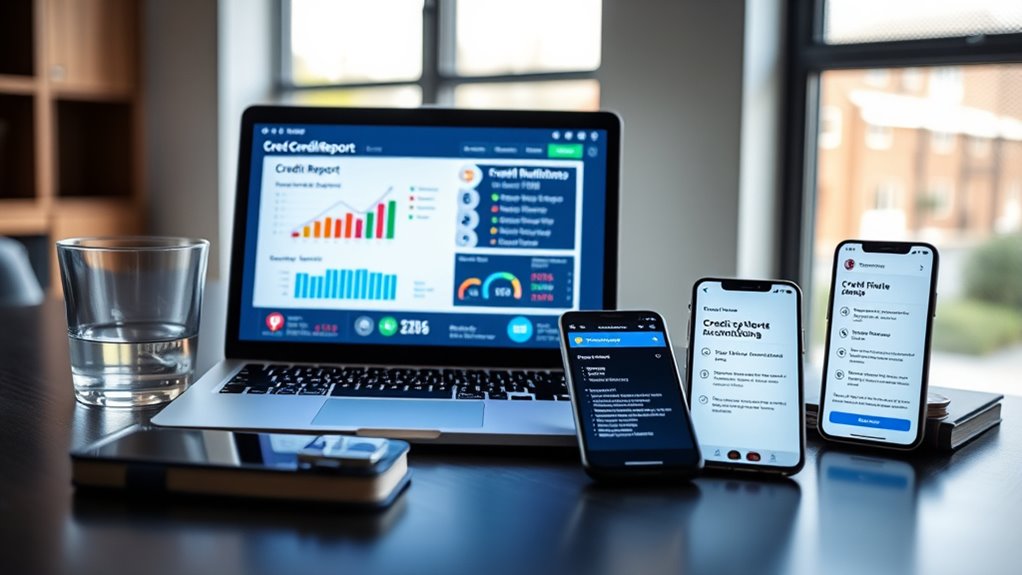
Credit monitoring helps you stay informed about changes to your credit reports by tracking activity such as new accounts or inquiries. When you sign up for a monitoring service, you receive alerts whenever something unusual happens on your credit reports. These notifications can help you spot potential signs of identity theft early, like unfamiliar accounts or sudden changes in your credit profile. Regularly reviewing credit report accuracy can further ensure your information remains correct and protected, especially since credit reporting plays a critical role in your financial security. Most services scan your reports regularly, sometimes daily, and send you updates via email or app notifications. Some providers offer free monitoring, while others charge a fee for more detailed alerts or additional features. Keep in mind, credit monitoring doesn’t prevent unauthorized activity—it only helps you detect it quickly so you can take action. Utilizing security freezes can add an extra layer of protection by restricting access to your credit reports altogether. Incorporating fraud detection tools can further enhance your ability to identify suspicious activities early. Staying aware of identity theft risks is also essential in maintaining your overall financial well-being.
The Benefits and Limitations of Credit Monitoring Services

Credit monitoring services can alert you early to suspicious activity, helping you spot potential fraud quickly. However, they don’t prevent unauthorized access or new accounts from being opened in your name. Understanding these benefits and limitations helps you decide if monitoring fits your security needs. Additionally, vetted products are available that prioritize safety and effectiveness for protecting your personal information. Recognizing confidentiality risks can further inform your decision on whether to supplement monitoring with security freezes. Being aware of the Home Heating Solutions available, such as heat pump noise levels and retrofit options, can also contribute to a more comprehensive approach to your overall safety and comfort. Considering credit freeze processes can provide an added layer of security by preventing new accounts from being opened without your consent. Incorporating identity theft prevention strategies can further strengthen your defenses against unauthorized use of your personal data.
Early Fraud Detection
While credit monitoring services can be a valuable tool for catching fraudulent activity early, they do have limitations. These services alert you when there’s unusual activity on your credit report, such as new accounts or inquiries, giving you a head start in spotting identity theft. However, they don’t prevent fraud from occurring, so you’re still vulnerable until you catch the problem. Sometimes, alerts can be delayed or missed if the fraud occurs before monitoring begins or if activity falls outside the parameters set by the service. Additionally, monitoring does nothing to stop unauthorized access—only to notify you afterward. Consequently, while it enhances early detection, relying solely on credit monitoring isn’t enough; combining it with other protections provides a more thorough defense. Incorporating Best Modern Toilet features, such as upgraded toilets with advanced flushing mechanisms, can also help prevent plumbing issues that might lead to security concerns in homes. Implementing identity theft prevention strategies, like freezing your credit, can provide an extra layer of security by restricting access to your credit reports altogether. Research shows that comprehensive security measures, including credit freezes and vigilant monitoring, are essential for a well-rounded approach to personal data protection.
No Prevention of Access
Although credit monitoring services can alert you to suspicious activity, they don’t prevent unauthorized access to your credit reports. If a thief tries to open a new account or access your report, you’ll be notified after the fact, but they might have already gained access. This means your credit report remains vulnerable until you respond to alerts, which might be too late to stop the damage. Credit monitoring is useful for early detection, but it doesn’t block or restrict access. So, if you’re looking to actively prevent unauthorized activity, monitoring alone isn’t enough. Implementing a credit freeze can restrict access and stop fraud before it happens. Regular pre-flight checks of your credit reports can also help identify potential issues early on. Additionally, understanding the Vetted Grobal World system can provide insights into broader security practices to protect your financial information.
Exploring the Concept of Credit Freezes and Their Advantages

Have you ever wondered how to effectively protect your credit report from unauthorized access? Credit freezes are a powerful tool for this purpose. They restrict access to your credit report, making it nearly impossible for identity thieves to open new accounts in your name. Best of all, placing a freeze is free and available to everyone. Once activated, it remains in effect until you decide to lift it, giving you control over your credit security.
Consider these advantages:
- Prevents unauthorized account opening
- Free to initiate and lift
- Legally mandated and accessible
- Limits access to your credit report
- Ideal for long-term protection
A credit freeze offers robust defense against identity theft by blocking access, making it harder for fraudsters to misuse your information. Additionally, understanding how security systems in homes provide protection can help you enhance your overall security measures.
How to Place and Lift a Credit Freeze Effectively
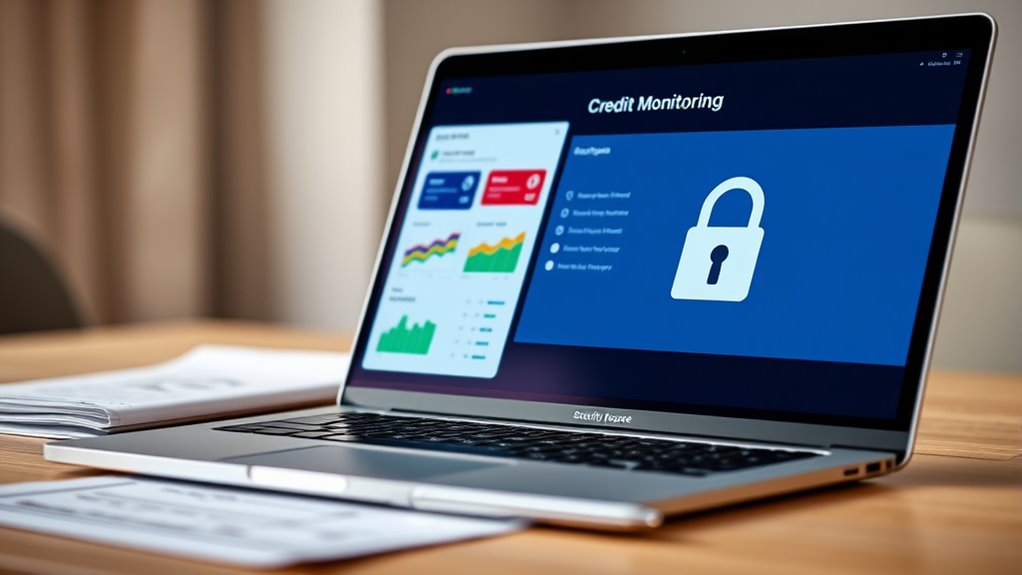
To place a credit freeze effectively, you need to contact each of the three major credit bureaus separately, either online or by phone, and provide the necessary identification. When lifting the freeze, make sure to do so securely using your PIN or password, and confirm the timing to avoid delays. Following these steps carefully guarantees your credit remains protected or accessible when needed. Additionally, understanding the reliability of your backup power options can help you stay prepared in emergencies, just as safeguarding your credit is essential in financial security. Implementing proper watering techniques for your household accounts, such as monitoring your credit reports regularly, can further enhance your financial health. Being aware of how somatic therapy techniques can support emotional resilience may also aid in managing stress related to credit concerns.
Placing a Freeze Properly
Placing a credit freeze correctly involves contacting each of the three major credit bureaus—Equifax, Experian, and TransUnion—individually to request the freeze. You can do this online, by phone, or by mail. To guarantee the process goes smoothly:
- Have your personal identification ready, such as your Social Security number and proof of identity.
- Create a secure account or PIN with each bureau for future lift requests.
- Follow each bureau’s specific instructions carefully.
- Confirm the freeze is in place by checking your credit reports.
- Keep your PINs or passwords secure, as you’ll need them to lift the freeze later.
Taking these steps ensures your freeze is properly set, providing maximum protection against unauthorized access.
Lifting a Freeze Safely
Lifting a credit freeze safely requires careful planning to prevent unauthorized access while ensuring you’re able to resume normal credit activity when needed. First, gather your PIN or password from each credit bureau where you’ve placed the freeze. Contact each bureau separately, either online, by phone, or through their app, to request the lift. Clearly specify whether you want a temporary or permanent removal. Confirm your identity by providing the required information. Once the freeze is lifted, verify that your credit reports are accessible. Be mindful of timing—lifting a freeze too early or forgetting to re-freeze after completing your transactions can expose you to risks. Always keep your PINs secure and document your requests for future reference.
Comparing Protection Levels: Credit Freeze vs. Credit Monitoring

While both credit freezes and credit monitoring aim to protect you from identity theft, they offer different levels of security. A credit freeze blocks access to your credit reports, making it nearly impossible for thieves to open new accounts without your PIN. Credit monitoring, on the other hand, tracks changes in your reports and sends alerts, helping you spot suspicious activity early.
Consider these protection differences:
- Freezes prevent new accounts but don’t alert you to existing activity.
- Monitoring provides real-time alerts for changes or inquiries.
- Freezes are free and require separate requests for each bureau.
- Monitoring services might charge a fee, depending on the provider.
- Combining both offers comprehensive, layered protection.
Cost Considerations and Convenience Factors
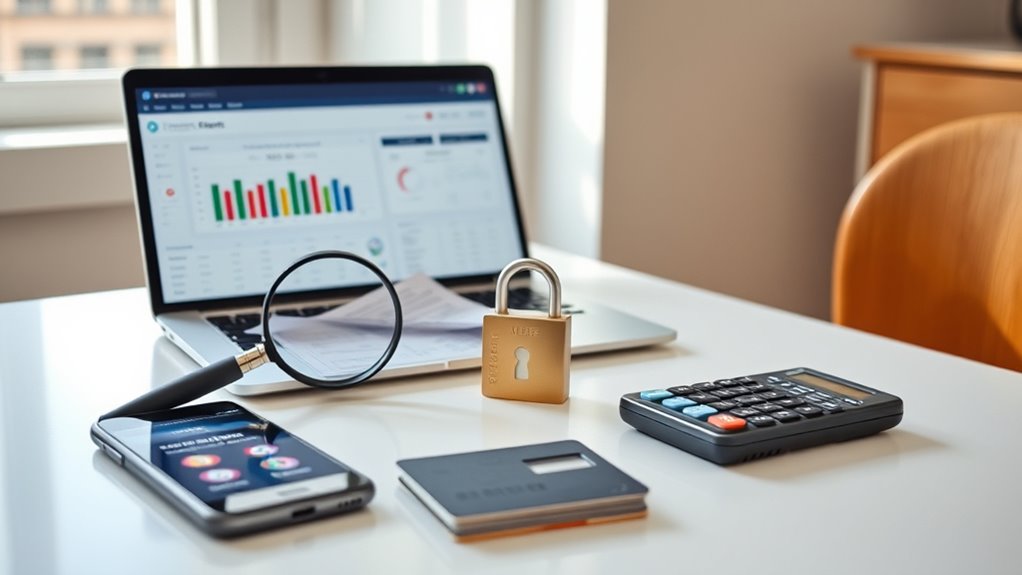
Cost considerations and convenience factors play a significant role in choosing between credit monitoring and security freezes. Credit monitoring services can cost anywhere from free to around $20 a month, depending on the provider and features. While they offer ongoing alerts, managing multiple accounts may require subscriptions, which adds up over time. In contrast, security freezes are free to place and lift, making them a budget-friendly option. However, each freeze must be individually managed with each credit bureau, which can be time-consuming. Credit monitoring is more convenient for quick access to alerts and ongoing oversight without extra effort. Conversely, freezes demand more effort upfront but provide stronger protection. Your decision will depend on whether you prioritize lower cost and ease or long-term security and control.
Situations Where Each Measure Is Most Suitable
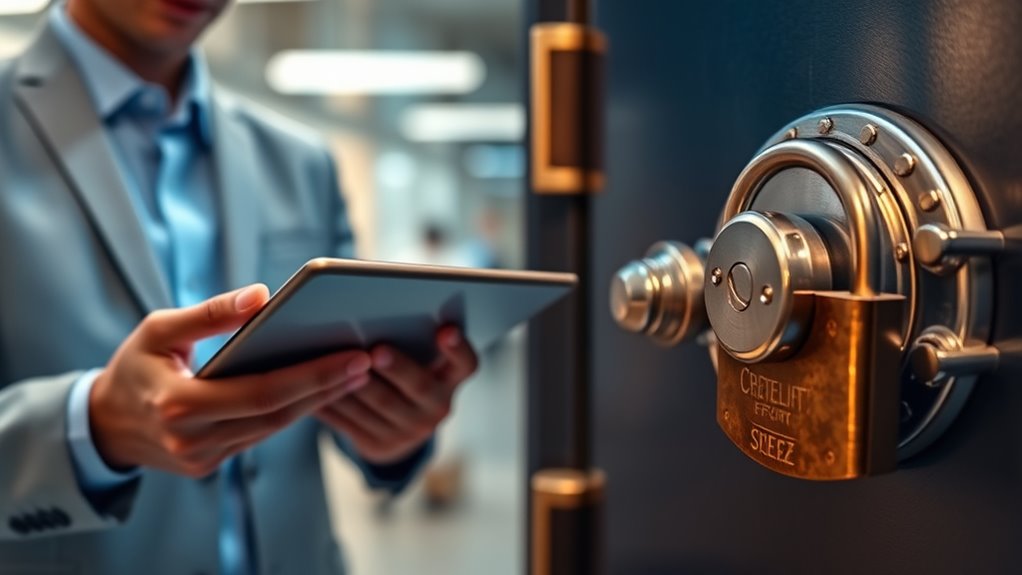
Situations where each protection measure is most suitable depend on your specific risk level and lifestyle. If you frequently apply for credit, open new accounts, or suspect fraud, credit monitoring can quickly alert you to suspicious activity. It’s ideal for ongoing oversight and peace of mind. Conversely, if you’re planning to be inactive for a long period or want long-term security, a credit freeze offers stronger protection by blocking new account access entirely. Consider a freeze if you’ve experienced identity theft or want to prevent unauthorized credit activity. Use a credit freeze when you want to minimize risk during periods of vulnerability. Meanwhile, credit monitoring suits those with active credit needs, providing real-time alerts. Both measures can be combined for extensive protection.
Combining Strategies for Enhanced Identity Theft Prevention

Combining credit monitoring and security freezes creates a thorough approach to protecting your identity. By implementing a freeze, you block unauthorized access to your credit reports, preventing new accounts from being opened without your knowledge. Meanwhile, credit monitoring keeps you informed of any activity on your existing reports, alerting you to suspicious actions or inquiries. Using both methods together maximizes your defenses: the freeze stops malicious actors from establishing new lines of credit, and monitoring detects ongoing or attempted fraud on existing accounts. This layered strategy makes it harder for thieves to succeed and ensures you’re quickly aware of any unauthorized activity. Combining these tools allows you to proactively safeguard your credit while maintaining oversight, giving you greater peace of mind.
Frequently Asked Questions
Can I Use Both Credit Freeze and Monitoring Simultaneously?
Yes, you can use both a credit freeze and monitoring at the same time. Doing so gives you stronger protection against identity theft. The freeze blocks access to your credit reports, preventing new accounts, while monitoring alerts you to suspicious activity on your reports. Keep in mind, you’ll need to manage each separately, but combining these measures offers thorough security, especially if you’re concerned about potential fraud.
Do Credit Freezes Affect My Credit Score?
Think of a credit freeze as a gentle shield that doesn’t leave a mark on your score. It doesn’t directly impact your credit score because it simply blocks access to your report, preventing new accounts from being opened. You can lift or reapply the freeze when needed without worrying about your credit standing. So, rest assured, freezing your credit keeps you protected without any negative effect on your score.
How Long Does It Take to Lift a Credit Freeze?
Lifting a credit freeze usually takes a few hours to a few days, depending on the credit bureau and how you request it. If you do it online, it’s often instant or within a few hours. By phone or mail, it might take a couple of days. To guarantee quick access, keep your PIN or password handy, and plan ahead if you need the freeze lifted for a new credit application.
Are There Any Risks Associated With Credit Monitoring Services?
Like walking a tightrope, credit monitoring services carry some risks. You might expose your personal information if the provider isn’t secure, or fall victim to scams if you aren’t cautious. Some services could charge hidden fees, or send false alerts that cause unnecessary worry. To stay safe, choose reputable providers, read privacy policies carefully, and keep your details private. Staying alert helps you avoid the pitfalls and keeps your credit secure.
Is Credit Freeze Effective Against Existing Credit Accounts?
A credit freeze doesn’t affect your existing credit accounts, so your current accounts remain accessible and functional. It specifically prevents new lenders from viewing your credit report, making it harder for thieves to open fraudulent accounts. However, it doesn’t stop unauthorized activity on accounts you already have. To protect existing accounts, you should also monitor your activity regularly and consider additional security measures like fraud alerts.
Conclusion
Ultimately, choosing between credit monitoring and a security freeze is like selecting the right shield or sword—you need the right tool for the battle. While monitoring keeps watch like a vigilant eye, freezing acts as a fortress, locking out threats. Combining both creates a layered defense, turning vulnerability into resilience. Stay proactive, adapt your strategy, and let these tools work in harmony—your best armor against identity theft’s unpredictable tides.
